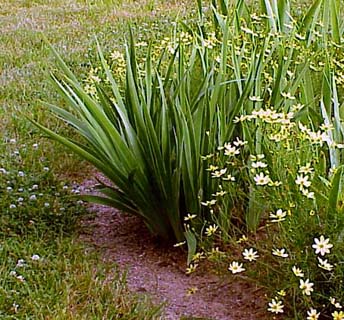USESLANDSCAPESiberian Irises are excellent landscape plants, easy to grow, appreciating mulch, with elegant vertical blue-green foliage that looks good on many varieties throughout the growing season.Other irises work well in specimen plantings or in borders, although in many cases mulch should be avoided. The large and impressive flowers of the tall bearded have made it a garden favorite. However, some shorter varieties are also notable and excellent choices in areas where wind may topple the taller ones. Miniature tall bearded clumps often send up many stalks to create a beautiful garden plant, looking good even after a few stalks are cut for the table.
In wet environments, Louisianas, Japanese, Laevigatas, and Pseudacorus will flourish, even in shallow water. Siberians grow well in adjacent areas, but do best where there is no standing water. I. cristata is an interesting groundcover-like planting that works well in partial shade. I. tectorum, slightly larger, also works well in partial shade. Both have wide, gracefully arching fans. These cannot bear traffic, but make excellent contrast to many other plants in woodsy, untraveled areas. I. graminea is one of the tiniest Spurias, with deep green narrow leaves, attractive in a border, does well in partial shade.
CUTTINGMany irises have been used as cut flowers. AIS-affiliated groups often sponsor shows during bloom season to show off many varieties.Longest lasting are the Dutch. Florists tend to use these almost exclusively. Spurias are also great cut flowers, lasting pretty long and having some of the most showy blooms. Depending on where you are, they may be temperamental to grow. They have interesting flower shapes and serve as impressive elements for arrangements. Louisianas are good cut flowers, having colorful and showy blooms. Siberians are possibilities for cutting too, and probably the easiest to grow many places. For long seasons, pick repeat bloomers like Lavender Bounty and Reprise. Flowers are small and elegant, and won't last as long as some of those above. For slightly larger flowers, consider tetraploid varieties. Japanese Irises often have very large blooms, which are impressive and interesting as they open, but do fold up when the show is over. One Japanese tradition is to bring potted plantsinside to watch them "act" over three days. Among beardeds, my favorites for cutting are the Miniature Tall Beardeds, which have also commonly been called Table Irises. Their scale is appropriate to a table centerpiece, and established plants send up great quantities of bloomstalks. These also won't last forever, but there will be more outside to pick. They have been used in weddings, and they work well in flower arrangements Other bearded irises work well as cut flowers too, each with its own effect. Generally, the Dutch and MTBs will bloom first, followed by the Siberians and Spurias, with the Japanese right on their heels. |
 Although some people
have said that iris foliage is not attractive, even bearded iris foliage can
be valuable in the garden. Take care to choose varieties with foliage resistant
to disease, and if leaf spot or other problems should develop, spray with an
appropriate fungicide to prevent them from expanding. Above is a miniature
tall bearded iris, MYSTIC GLOW, providing a counterpoint to one of my favorite
companion plants, coreopsis 'Moonbeam'.
Although some people
have said that iris foliage is not attractive, even bearded iris foliage can
be valuable in the garden. Take care to choose varieties with foliage resistant
to disease, and if leaf spot or other problems should develop, spray with an
appropriate fungicide to prevent them from expanding. Above is a miniature
tall bearded iris, MYSTIC GLOW, providing a counterpoint to one of my favorite
companion plants, coreopsis 'Moonbeam'.